Don't miss any stories → Follow Tennis View
FollowContinuity and Change: Madrid’s Return to Red
All of the tennis action last week converged on Madrid, which held the most significant joint event of the Road to Roland Garros. Back on red clay after a failed experiment on blue clay, the tournament saw some notable differences from last year’s results but also some continuities. Each of its two champions illustrated one of these trends.
 Serena Williams: The world No. 1 doesn’t care whether Madrid is played on blue clay, red clay, or some shade yet to be invented. Serena tottered on the verge of a shocking defeat in her quarterfinal and never produced her most convincing tennis here but still defended her Premier Mandatory title while retaining the top spot. Around this time last year, most observers dubbed this veteran the favorite for Roland Garros, and she probably should claim that status again. Ending Maria Sharapova’s winning streak on red clay, Serena confirmed her dominant position in that rivalry that their Miami three-setter had threatened to question. With many of the top-ten women beyond Sharapova struggling for form or averse to clay, she may have the most to fear from dark horses whom she overlooks. But that’s a common theme of her career. A
Serena Williams: The world No. 1 doesn’t care whether Madrid is played on blue clay, red clay, or some shade yet to be invented. Serena tottered on the verge of a shocking defeat in her quarterfinal and never produced her most convincing tennis here but still defended her Premier Mandatory title while retaining the top spot. Around this time last year, most observers dubbed this veteran the favorite for Roland Garros, and she probably should claim that status again. Ending Maria Sharapova’s winning streak on red clay, Serena confirmed her dominant position in that rivalry that their Miami three-setter had threatened to question. With many of the top-ten women beyond Sharapova struggling for form or averse to clay, she may have the most to fear from dark horses whom she overlooks. But that’s a common theme of her career. A
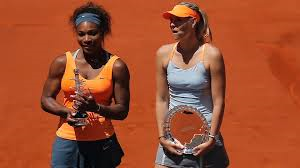
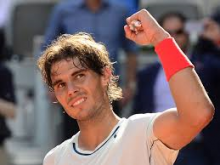 Rafael Nadal: Although he defeated no opponent more notable than David Ferrer, Nadal continued to establish himself as the men’s favorite at Roland Garros. Outside the first half of his quarterfinal, he looked more poised than he had for much of Barcelona and Monte Carlo. Rafa had agitated vigorously for the return of the red clay at his home Masters 1000 tournament, so this title must have felt like a vindication of his views. Despite the altitude and the occasional odd bounces that the hastily laid surface produced, Nadal managed to impose the same relentlessly physical brand of tennis on Madrid that has defined his clay reign elsewhere. He can claim a top-four seed at Roland Garros by winning Rome next week, although perhaps his rivals should be more concerned about his seed than him. A
Rafael Nadal: Although he defeated no opponent more notable than David Ferrer, Nadal continued to establish himself as the men’s favorite at Roland Garros. Outside the first half of his quarterfinal, he looked more poised than he had for much of Barcelona and Monte Carlo. Rafa had agitated vigorously for the return of the red clay at his home Masters 1000 tournament, so this title must have felt like a vindication of his views. Despite the altitude and the occasional odd bounces that the hastily laid surface produced, Nadal managed to impose the same relentlessly physical brand of tennis on Madrid that has defined his clay reign elsewhere. He can claim a top-four seed at Roland Garros by winning Rome next week, although perhaps his rivals should be more concerned about his seed than him. A
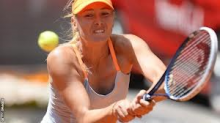 Maria Sharapova: Earlier in her career, few would have considered Sharapova a paragon of consistency or a serious threat on red clay. Yet she has become both since her comeback from shoulder surgery, most recently reaching the semifinals at all six of her tournaments this year, including four straight finals, and reeling off a longer red-clay winning streak than any woman since 2000. That streak predictably came to an end at Serena’s hands, but not before Sharapova had rolled through five overmatched foes without dropping a set. The last of her victories in Madrid marked the 500th of her career, a milestone that she attained just weeks after turning 26 despite extended injury absences. Sharapova claimed it in signature style by scorching a cross-court forehand at an improbable angle. A
Maria Sharapova: Earlier in her career, few would have considered Sharapova a paragon of consistency or a serious threat on red clay. Yet she has become both since her comeback from shoulder surgery, most recently reaching the semifinals at all six of her tournaments this year, including four straight finals, and reeling off a longer red-clay winning streak than any woman since 2000. That streak predictably came to an end at Serena’s hands, but not before Sharapova had rolled through five overmatched foes without dropping a set. The last of her victories in Madrid marked the 500th of her career, a milestone that she attained just weeks after turning 26 despite extended injury absences. Sharapova claimed it in signature style by scorching a cross-court forehand at an improbable angle. A
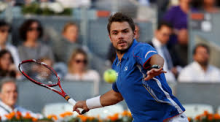 Stanislas Wawrinka: Over the last month, the Swiss No. 2 has defeated half of the top eight men on clay. Two of those victories came over Jo-Wilfried Tsonga and Tomas Berdych in Madrid, setting up his second Masters 1000 final. Wawrinka finished runner-up, as he had in Rome five years ago, but he will return to the top ten next week in a tribute to his outstanding spring form. Rallying to defeat not only Berdych but rising sensation Grigor Dimitrov, he showed more competitive grit than most associate with him. The epic five-set loss to Djokovic at the Australian Open may have lit the fuse of what could become Wawrinka’s most impressive season ever. At the foundation of it is one of the ATP’s most spectacular backhands, a fusion of power and grace. A
Stanislas Wawrinka: Over the last month, the Swiss No. 2 has defeated half of the top eight men on clay. Two of those victories came over Jo-Wilfried Tsonga and Tomas Berdych in Madrid, setting up his second Masters 1000 final. Wawrinka finished runner-up, as he had in Rome five years ago, but he will return to the top ten next week in a tribute to his outstanding spring form. Rallying to defeat not only Berdych but rising sensation Grigor Dimitrov, he showed more competitive grit than most associate with him. The epic five-set loss to Djokovic at the Australian Open may have lit the fuse of what could become Wawrinka’s most impressive season ever. At the foundation of it is one of the ATP’s most spectacular backhands, a fusion of power and grace. A
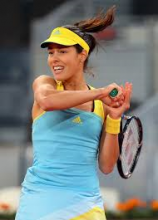 Ana Ivanovic: Building upon a fine week in Stuttgart, she reached her first Premier Mandatory semifinal since Indian Wells four years ago. Ivanovic narrowly survived an uneven three-setter against Laura Robson, but the experience of winning without her best tennis may have benefited her as much as her more brilliant performances those weeks. Nearly flawless in dismissing world No. 6 Angelique Kerber, she will reap rewards once she realizes that perfection is not always required. The Serb has placed herself within range of the top ten if she can maintain this level at Rome and Roland Garros, where she will arrive as a woman to watch. A-
Ana Ivanovic: Building upon a fine week in Stuttgart, she reached her first Premier Mandatory semifinal since Indian Wells four years ago. Ivanovic narrowly survived an uneven three-setter against Laura Robson, but the experience of winning without her best tennis may have benefited her as much as her more brilliant performances those weeks. Nearly flawless in dismissing world No. 6 Angelique Kerber, she will reap rewards once she realizes that perfection is not always required. The Serb has placed herself within range of the top ten if she can maintain this level at Rome and Roland Garros, where she will arrive as a woman to watch. A-
 Grigor Dimitrov: He had shown signs of breaking through earlier in the spring, serving for sets against Djokovic and Murray. Then Dimitrov won a set from Nadal at Monte Carlo, revealing improved defense and fitness. In Madrid, he notched his first career triumph over one of the ATP Big Four in memorable fashion, surviving a three-set, two-tiebreak epic that sprawled across three hours. Plot twists proliferated, and emotions ran high, but somehow Dimitrov overcame his relative inexperience and visible nerves to propel his career a huge step forward. He credited advice from girlfriend Sharapova as inspiration before the match. A
Grigor Dimitrov: He had shown signs of breaking through earlier in the spring, serving for sets against Djokovic and Murray. Then Dimitrov won a set from Nadal at Monte Carlo, revealing improved defense and fitness. In Madrid, he notched his first career triumph over one of the ATP Big Four in memorable fashion, surviving a three-set, two-tiebreak epic that sprawled across three hours. Plot twists proliferated, and emotions ran high, but somehow Dimitrov overcame his relative inexperience and visible nerves to propel his career a huge step forward. He credited advice from girlfriend Sharapova as inspiration before the match. A
Wildcards: Tournament directors always feel rewarded when a player who gets a free pass into the main draw puts on a fine display. Two WTA wildcards shone in Madrid, Daniela Hantuchova upsetting Petra Kvitova and home favorite Anabel Medina Garrigues thrusting Serena within two points of defeat. Hantuchova never had won a set from Kvitova before, while the Spanish clay specialist became the first woman other than Venus to bagel Serena since 2007. In the ATP draw, fellow wildcard Pablo Andujar improbably marched all the way to the semifinals. Andujar had won just five matches since last year’s US Open, so his run ranked among the most surprising events of a week filled with surprises. The Spaniard will see his ranking soar after upsetting two seeded opponents, and reaching the semifinals at his nation’s most prestigious tournament represents the best achievement of his career. A-
WTA rising stars: Russian by birth and Kazakh by passport, former junior No. 1 Yulia Putintseva not only qualified for this Premier Mandatory main draw but took Serena Williams to a tiebreak in the first round. The small, fiery Putintseva found her achievement overshadowed by the tall, fiery Laura Robson. This former Wimbledon junior champion deployed her lefty weapons to devastating effect in two main-draw victories, including an upset of the fourth-seeded Radwanska. While Robson must improve her serve and consistency, she already has registered victories over several of the WTA’s leading ladies. Skip a grade
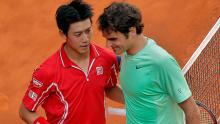 Kei Nishikori: On his weakest surface, he toppled defending champion Federer with a performance more sturdy than spectacular. Nishikori has flown beneath the radar for most of his career, partly because of injuries, but he has won two ATP 500 tournaments since last fall and embedded himself in the top 20. This Bolletieri student could make a real run at the top ten this summer, although (like Dimitrov) he still needs to learn how to consolidate momentum during the schedule’s weekly grind. B+
Kei Nishikori: On his weakest surface, he toppled defending champion Federer with a performance more sturdy than spectacular. Nishikori has flown beneath the radar for most of his career, partly because of injuries, but he has won two ATP 500 tournaments since last fall and embedded himself in the top 20. This Bolletieri student could make a real run at the top ten this summer, although (like Dimitrov) he still needs to learn how to consolidate momentum during the schedule’s weekly grind. B+
Unseeded WTA quarterfinalists: Troubled by injury when the year began, Kanepi gradually played herself into form during this clay season. She secured three main-draw victories in Madrid, highlighted by an upset of clay specialist Carla Suarez Navarro. That surge should give her hope that she can defend some of her Roland Garros quarterfinal points. Perhaps more unexpected was the winning streak of Ekaterina Makarova, who rallied past Azarenka in three sets and backed up that result with an upset of 14th-seeded Marion Bartoli. This lefty’s style seems poorly designed for the long rallies of clay, so one should not read too much into this result. B+
 Tomas Berdych: His game can wreak havoc on clay because of his ability to penetrate slow surfaces with his forehand, combined with the extra time to set up his shots. Berdych did capitalize on those assets in an effort much improved from his last few tournaments. Still, he let the semifinal get away from him against a lower-ranked opponent when he stood on the verge of claiming a stranglehold over the third set. As Wawrinka said later, Berdych is not among the game’s best closers. B+
Tomas Berdych: His game can wreak havoc on clay because of his ability to penetrate slow surfaces with his forehand, combined with the extra time to set up his shots. Berdych did capitalize on those assets in an effort much improved from his last few tournaments. Still, he let the semifinal get away from him against a lower-ranked opponent when he stood on the verge of claiming a stranglehold over the third set. As Wawrinka said later, Berdych is not among the game’s best closers. B+
David Ferrer: Crushed by Nadal in the Acapulco final this spring, he nearly earned his revenge in Madrid before enduring a different type of embarrassment. Astonishingly, Ferrer outplayed his countryman for most of the first two sets, cracking his ground strokes with confidence and dictating points from the center of the court. But, even as Nadal scrambled and scowled, he surely knew that his 14-match winning streak against Ferrer would count for something. When the older Spaniard failed to put away a ball that would have given him double match point, the collapse lay just around the corner. For the third time in four clay matches, Ferrer ate a bagel from his celebrated countryman. Every tournament seems to offer a new flavor of adversity to test his stern resolve. B+
Italian women: On their best surface, Roberta Vinci and Sara Errani enjoyed drastically different fortunes. The former fell in the first round to Varvara Lepchenko, the second time that she has lost to the American this year. Much more fruitful was the week compiled by Errani, who bounced back from an early exit in Stuttgart to reach the semifinals. She defied the trend that saw taller, stronger women succeed in Madrid and proved that a more traditional clay style could flourish there too. B
 Andy Murray: Avoiding the embarrassment that he suffered in Monte Carlo, Murray carved out a respectable result with a quarterfinal. He also assured himself the No. 2 seed at Roland Garros, although it’s hard to rank him as a leading title threat there. Murray may conserve some of his emotional energy for the grass, for his clay game can border on the perfunctory. Like Berdych, he notched his 400th career victory this week. B-
Andy Murray: Avoiding the embarrassment that he suffered in Monte Carlo, Murray carved out a respectable result with a quarterfinal. He also assured himself the No. 2 seed at Roland Garros, although it’s hard to rank him as a leading title threat there. Murray may conserve some of his emotional energy for the grass, for his clay game can border on the perfunctory. Like Berdych, he notched his 400th career victory this week. B-
Jelena Jankovic: Rocketing to a 10-1 record on clay west of the Atlantic Ocean, Jankovic won a small tournament in Bogota, Colombia and reached the final in Charleston. (Between those events, she also reached a Premier Mandatory semifinal in Miami.) On clay east of the Atlantic Ocean, the former world No. 1 has dropped two of three matches. The one victory did come against Samantha Stosur, but it preceded consecutive losses to Sabine Lisicki and Chanelle Scheepers, players whose clay talents fall well short of Jankovic’s abilities. C
Victoria Azarenka: The woman who finished the Australian Open with the No. 1 ranking had vanished from the battlefield following an ankle injury at Indian Wells. Returning to her least productive surface after a lengthy absence, Azarenka could not have expected much from herself in Madrid. She wobbled through one match that she easily could have lost and then ran out of fuel against Makarova. Having reached the final in Madrid the last two years, Azarenka falls further behind Serena and Sharapova in the rankings. Her ankle appeared to give her no discomfort, though, which is what matters most moving forward. Incomplete
WTA Nos. 8-10: After the first two rounds of Madrid, six of the top ten women were gone. This carnage countered a growing sense that a WTA elite had started to crystallize after a period of anarchy. Below that more consistent elite lies the trio of Petra Kvitova, Samantha Stosur, and Caroline Wozniacki, who have clung desperately to their perches in the top ten amid long-term droughts. They won one total match among them in Madrid, in part victimized by drawing dangerous clay specialists in early rounds but also undone by their own erratic play. The most alarming part? It wasn’t all that surprising in view of their seasons so far. C-
 Top two ATP seeds: Both Novak Djokovic and Roger Federer might deserve failing grades for winning one total match between them. While Djokovic had not lost his first match at a clay tournament since 2006, Federer travels to Rome as the only man in the ATP top 15 who has not reached a final this year. But both could cite plausible alibis for their stumbles. The Serb had practiced little before the tournament as an ankle injury lingered, while the Swiss had not played since Indian Wells and showed understandable rust on his weakest surface. D
Top two ATP seeds: Both Novak Djokovic and Roger Federer might deserve failing grades for winning one total match between them. While Djokovic had not lost his first match at a clay tournament since 2006, Federer travels to Rome as the only man in the ATP top 15 who has not reached a final this year. But both could cite plausible alibis for their stumbles. The Serb had practiced little before the tournament as an ankle injury lingered, while the Swiss had not played since Indian Wells and showed understandable rust on his weakest surface. D
WTA Nos. 4 and 5: The fourth-ranked Agnieszka Radwanska opened 2013 in torrid form, winning consecutive small titles before the Australian Open. Since then, her level has dropped perceptibly as even her victories have become more arduous. In Madrid, where she introduced a new blonde hairstyle, the bottom dropped out in a resounding loss to Robson. But Radwanska rarely has enjoyed her trips to European clay, which is not the case for 2011 Roland Garros champion Li Na. Undefeated against opponents outside the top five since last fall, Li won just five games in her Madrid opener from lucky loser Madison Keys. This rising star had come within a tiebreak of defeating her in January, but still coach Carlos Rodriguez will not be happy with an all-too-familiarly inexplicable loss by his charge. F
Robin Haase: It may seem harsh to criticize someone who qualified for the main draw and then upset a higher-ranked opponent (Alexandr Dolgopolov) in the first round. In that match, though, Haase set an undesirable ATP record by losing his 15th consecutive tiebreak. He then took Tsonga to two tiebreaks in the next match. No prizes for guessing what happened in those. Repeat a grade
Madrid crowd: Their absence from many of the matches sucked the atmosphere out of an otherwise grim venue. When they did make their presence felt, unsportsmanlike behavior such as booing Djokovic or ground stroke winners by Nadal’s opponents caused one to wish them gone again. The latter issue arose for the first time this year, though, so maybe it will remain an anomaly. Probation
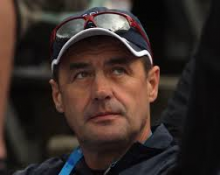 John Tomic: Perhaps the saddest tennis headline of the year emerged when John Tomic, the father of Australian star Bernard Tomic, assaulted his hitting partner at a Madrid hotel. This incident marked merely the latest, most public, and most extreme in a long history of erratic behavior from Tomic’s father. It might prove a blessing in disguise for his career, though, driving Bernard to finally cut the cord of an abusive relationship. Australian Davis Cup captain Patrick Rafter will assist him at Roland Garros, for the ATP and ITF rightly have banned John from tournaments pending the investigation’s results. Expelled
John Tomic: Perhaps the saddest tennis headline of the year emerged when John Tomic, the father of Australian star Bernard Tomic, assaulted his hitting partner at a Madrid hotel. This incident marked merely the latest, most public, and most extreme in a long history of erratic behavior from Tomic’s father. It might prove a blessing in disguise for his career, though, driving Bernard to finally cut the cord of an abusive relationship. Australian Davis Cup captain Patrick Rafter will assist him at Roland Garros, for the ATP and ITF rightly have banned John from tournaments pending the investigation’s results. Expelled










